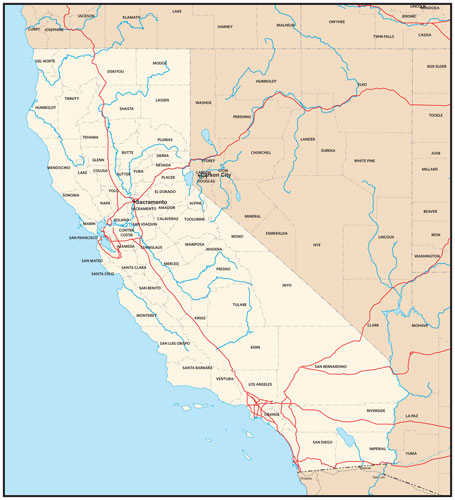Sign up for the Family Tree Newsletter Plus, you’ll receive our 10 Essential Genealogy Research Forms PDF as a special thank you!
Get Your Free Genealogy Forms
"*" indicates required fields
California’s vast territory and varied cultures make it seem more like a nation — which it was briefly in 1846 — than a state. Eyed by England and Russia, California was first settled by the Spanish: Father Junipero Serra arrived at the future site of San Diego in 1769 and began a string of missions along El Camino Real (The Royal Highway). Missions would be crucial to the state’s history under Spain and, after 1821, Mexico. The Spanish divided California into four districts — San Diego, Monterey, San Francisco, and Santa Barbara — each with a presidio (prison) and at least one mission.
Americans had begun crossing the continent to California in 1841, forming the “Bear-Flag Republic” in 1846. The breakaway republic was swept into the US war with Mexico, becoming an American protectorate. California was ceded to the United States in 1848 and became a state two years later.
The fast track to statehood was paved with gold, famously discovered at Sutter’s Mill in 1848. More than 300,000 people — the most from New England, Pennsylvania and New York — followed the Gold Rush to California by 1854.
Also among early arrivals were Irish, Italians, and Chinese, whose numbers swelled from seven in 1848 to 20,000 in 1852. Many Chinese also worked on the transcontinental railroad, which linked California to the East in 1869. An 1880s real-estate boom attracted English, Germans, and transplants from the Midwest. After 1885, when Japanese could legally leave their native country, many came to California.
The Great Depression brought the “Okies,” whose plight was immortalized by John Steinbeck in The Grapes of Wrath. After the industrial boom of World War II, California’s population surged, including influxes of African Americans, Mexicans, and Southeast Asians. Today the “Golden State” is America’s most populous.
RESEARCH TIPS
- The biggest challenge facing California researchers can be getting official vital records from the state. Instead, try contacting the county recorder’s office where the document was recorded.
- The state library’s death index, 1905 to 1997, and its marriage index, 1949 to 1986, are online from 1940 at http://vitals.rootsweb.ancestry.com/ca/death/search.cgi.
- An often-overlooked resource is the collection of the Daughters of the American Revolution transcriptions of records, which includes cemeteries, Los Angeles baptisms, pioneer obituaries, Bibles, early wills, and veteran grave registrations.
- Since California is such a large and populous state, some of its counties are enormous. You should always try to pin down the exact locality of your ancestors before contacting an office or society for records.
- Unorthodox resources, such as newspapers, family letters, county records, cemetery inscriptions, etc., can sometimes assist you more in California research than traditional genealogical records.
CENSUS RECORDS
- Federal census: 1850, 1860, 1870, 1880, 1900, 1910, 1920, 1930
- Federal mortality schedules: 1850, 1860, 1870, 1880
- State census: 1852
- Los Angeles census: 1790, 1816, 1836, 1844
- Early mission censuses: 1790s
GENERAL RESOURCES
- California Local History: A Bibliography and Union List of Library Holdings: Supplement to the 2nd Edition Covering Works Published 1961 through 1970 edited by Margaret Miller Rocq (Stanford University Press, 1976)
- The California Locator: A Directory of Public Records for Locating People Dead or Alive in California by Laurie Nicklas (Nicklas Publishing Co., 1996)
- California Pioneer Register and Index, 1542-1848. Including Inhabitants of Calfornia, 1769-1800, and List of Pioneers by Hubert Howe Bancroft (Regional Publishing Co., 1964)
- California Research Outline by the Church of Jesus Christ of Latter-day Saints (online at http://www.familysearch.org/eng/search/RG/guide/california.asp)
- Contemporary Biography of California’s Representative Men, 2 vols., by Alonzo Phelps (Research Publications, Inc., 1968)
- The Foreign-Born Voters of 1872 compiled by Jim W. Faulkinbury (J.W. Faulkinbury, 1994)
- Genealogical Records of California by Sherman Lee Pompey (1968)
- Gold! German Transcontinental Travelers to California, 1849-1851 by Clifford Neal Smith (Westland Publications, 1988)
- An Index to the Biographies in 19th Century California County Histories by J. Carlyle Parker (Gale Research Co., 1979)
- Index to the DAR Records of the Families of the California Pioneers by the Solano County Genealogical Society (The Society, 1988-1990)
- The Spanish Borderlands; a Chronicle of Old Florida and the Southwest by Herbert Eugene Bolton (Yale University Press, 1921)
Return to the main California page
From the Family Tree Sourcebook
Also available: the State Research Guide Book, State Research Guides CD and The Researcher’s Guide to American Genealogy.
ADVERTISEMENT

